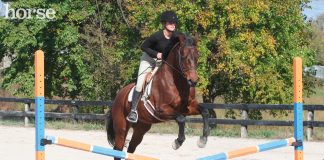The canter’s rocking-horse, three-beat rhythm presents a problem for novice riders trying to master their position at this gait. In trot, the rider’s body position remains stable since the horse’s head and neck don’t move in this two-beat gait. But in canter, the horse uses his head and neck for balance. Riders must learn to follow both the swing of the horse’s body with their seats—and accommodate the horse’s head and neck movement with forgiving arms and elbows.
“This is a lot to work on if you’re having trouble maintaining canter in the first place!” explains Ashley. So don’t attempt to train your green horse’s canter until you’re confident in your own ability to ride at this gait. “It is very difficult to put a green rider on a green horse and expect the canter to get better,” she says.
The very best way to learn to follow the canter is to take some longe lessons. “Working without stirrups on the longe line will help you enormously,” she counsels. “I have riders hold onto the pommel or cantle, so they can concentrate on following the canter in their hips.”
Ashley also suggests working on canter position by taking some lessons on an experienced horse, and ride without stirrups to strengthen your seat and leg.
When Your Horse Won’t Canter
Don’t let your green horse run into canter from an ever-increasing trot, explains Ashley. “You’re not doing your horse any favors by being unclear in your aids.”
Ride a 20-meter circle in trot and ask for canter. If your horse responds by trotting faster, bring him back to a steady working trot using the half-halt and ask for canter again.
This time, use a stronger forward aid—more leg, voice, or a touch of whip or spur—to the upward transition. Your horse may leap into canter; if so, reward him. Be careful not to inadvertently punish your horse by catching him in the mouth if he canters off faster than you’d like. Reward your horse for going forward, even if right now it’s a little more forward than you’d like.
Next time, try using less of the forward correction (if you used the whip last time, for example, try leg only this time), and see if your horse gets the idea. Stay on the circle, which will make it easier to keep your horse on your aids, while you repeat these transitions until your horse moves promptly into canter.





